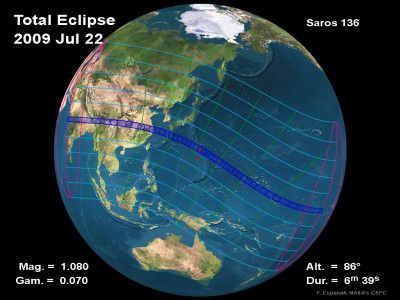From our front-page news:
Solar and lunar eclipses aren't too rare, but when one does occur, and you happen to live in the right location, then it's a real treat. For the uninitiated, where solar eclipses are concerned, there are four possible outcomes, but three of those four appear almost just as often as one another (partial, annular, total), while hybrid (a combination of annular and total) eclipses are very rare.
The last total solar eclipse to occur happened just last year, but one that happens later this week (July 22nd) is rather exciting, and with it, there's some good news, and bad news. The good news is that the totality stage of this particular eclipse will last longer than any other in the 21st century, at a staggering 6 minutes, 39 seconds. This duration won't be surpassed until 2132... so I wouldn't plan on holding out for it.
The bad news is that the vast majority of readers to this site will be unable to view even an inch of the eclipse, as it occurs on the other side of the globe. According to NASA, the absolute best place for viewing the totality stage is just outside of Patna, India, although a handful of cities in China will also be treated to the spectacle. If you live anywhere in China or the outlying regions, then you may still be able to view the partial stage of the eclipse.
If you happen to live in or around Asia, you can check out a larger version of the image below, provided by NASA, that gives a good idea of where the eclipse will be viewable. I'm horrible at figuring out times, but if my calculations are correct, you can view the eclipse anywhere from between 8:00AM - 10:30AM mainland China time. If you're planning to view, definitely pick up a newspaper to find out for sure.

On Wednesday, 2009 July 22, a total eclipse of the Sun is visible from within a narrow corridor that traverses half of Earth. The path of the Moon's umbral shadow begins in India and crosses through Nepal, Bangladesh, Bhutan, Myanmar and China. After leaving mainland Asia, the path crosses Japan's Ryukyu Islands and curves southeast through the Pacific Ocean where the maximum duration of totality reaches 6 min 39 s. A partial eclipse is seen within the much broader path of the Moon's penumbral shadow, which includes most of eastern Asia, Indonesia, and the Pacific Ocean.
Source: NASA - Solar Eclipse of July 22, 2009
The last total solar eclipse to occur happened just last year, but one that happens later this week (July 22nd) is rather exciting, and with it, there's some good news, and bad news. The good news is that the totality stage of this particular eclipse will last longer than any other in the 21st century, at a staggering 6 minutes, 39 seconds. This duration won't be surpassed until 2132... so I wouldn't plan on holding out for it.
The bad news is that the vast majority of readers to this site will be unable to view even an inch of the eclipse, as it occurs on the other side of the globe. According to NASA, the absolute best place for viewing the totality stage is just outside of Patna, India, although a handful of cities in China will also be treated to the spectacle. If you live anywhere in China or the outlying regions, then you may still be able to view the partial stage of the eclipse.
If you happen to live in or around Asia, you can check out a larger version of the image below, provided by NASA, that gives a good idea of where the eclipse will be viewable. I'm horrible at figuring out times, but if my calculations are correct, you can view the eclipse anywhere from between 8:00AM - 10:30AM mainland China time. If you're planning to view, definitely pick up a newspaper to find out for sure.

On Wednesday, 2009 July 22, a total eclipse of the Sun is visible from within a narrow corridor that traverses half of Earth. The path of the Moon's umbral shadow begins in India and crosses through Nepal, Bangladesh, Bhutan, Myanmar and China. After leaving mainland Asia, the path crosses Japan's Ryukyu Islands and curves southeast through the Pacific Ocean where the maximum duration of totality reaches 6 min 39 s. A partial eclipse is seen within the much broader path of the Moon's penumbral shadow, which includes most of eastern Asia, Indonesia, and the Pacific Ocean.
Source: NASA - Solar Eclipse of July 22, 2009
